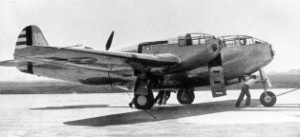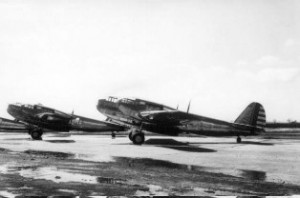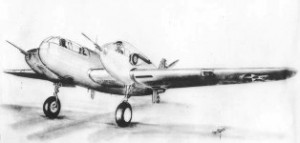Bell Airacuda
Bell Aircraft Corporation was founded in 1935 by Larry Bell. To gain experience in -for that time- modern aircraft constructions Bell started with contract work for Consolidated Aircraft Corporation (Convair). The work consisted of the manufacturing of wing parts of the Catalina flying boat.
 In 1936 Bell started under supervision of chief-engineer Robert J. Woods with the design of their first own airplane: the FM-1 Airacuda. The FM-1 was a twin-engined heavy fighter totally designed according to the philosophy of the air-cruiser: a well-armed plane with a multi-headed crew that could stay airborne for a long time, meanwhile creating havoc under enemy bomber formations with well-aimed fire from heavy board-guns from manned battle stations. This theory would fail in a disastrous way during the war years to come!
In 1936 Bell started under supervision of chief-engineer Robert J. Woods with the design of their first own airplane: the FM-1 Airacuda. The FM-1 was a twin-engined heavy fighter totally designed according to the philosophy of the air-cruiser: a well-armed plane with a multi-headed crew that could stay airborne for a long time, meanwhile creating havoc under enemy bomber formations with well-aimed fire from heavy board-guns from manned battle stations. This theory would fail in a disastrous way during the war years to come!
The main armament of the FM-1, later named the Airacuda, consisted of two Madsen cannons placed in manned gun positions in front of the both engines. In practice, this position was only possible by using pusher propellers. There were additional machine guns placed in various other locations as a defense against fighters escorting the enemy bombers.

 The first flight of the prototype XFM-1 was made on 1 September 1937 from the company airfield near Buffalo, New York. Basically, the test flights of the Airacuda were without too much problems . This was a good reason for the US Army air corps to place for operational evaluation an order for twelve pre-production YFM-1’s. These machines were quite different when compared with the prototype. One of the changes was the replacement of the curved windscreen of the cockpit canopy by an optical flat screen and the both gun blisters on each side of the fuselage were replaced by hatches. An extra gun-post was mounted on top of the fuselage and the the fuselage was fitted with a small bay for a possible bomb load. Also the inlet and exhaust system of the both engines was modified. The total dimensions also changed somewhat. Span, length and height became respectively 21.34 m; 14.02 m and 3.89 m. Also the empty weight increased.
The first flight of the prototype XFM-1 was made on 1 September 1937 from the company airfield near Buffalo, New York. Basically, the test flights of the Airacuda were without too much problems . This was a good reason for the US Army air corps to place for operational evaluation an order for twelve pre-production YFM-1’s. These machines were quite different when compared with the prototype. One of the changes was the replacement of the curved windscreen of the cockpit canopy by an optical flat screen and the both gun blisters on each side of the fuselage were replaced by hatches. An extra gun-post was mounted on top of the fuselage and the the fuselage was fitted with a small bay for a possible bomb load. Also the inlet and exhaust system of the both engines was modified. The total dimensions also changed somewhat. Span, length and height became respectively 21.34 m; 14.02 m and 3.89 m. Also the empty weight increased.
 In October 1940 the YFM-1A was introduced; one of the pre-production machines fitted with a nose wheel. Only three of this version were built. A further two YFM-1’s were fitted with slightly less powerful engines under the type designation YFM-1B.
In October 1940 the YFM-1A was introduced; one of the pre-production machines fitted with a nose wheel. Only three of this version were built. A further two YFM-1’s were fitted with slightly less powerful engines under the type designation YFM-1B.
Eventually the flight performances of the completely operationally equipped Airacudas were found to be somewhat disappointing. In particular the maximum speed of less than 450 km/h was totally inadequate. Also the light bomber version the plane was not found to be a success because of its instability. No further production orders were placed and the preproduction machines were never used in operational service.
The both Madsen cannons were never mounted; the cannons shown on pictures of the Airacuda were wooden dummies! All thirteen produced machines were assigned to training schools for aircraft technicians to serve as instructional airframes. Because of their size and complexity, they undoubtedly have been very successful in this role.
Technical details: For the XFM-1 prototype
power plant two Allison V-1710-13 12-cilinder liquid cooled in-line engines of 1150 hp each
wingspan 21.28 m
length 13.66 m
height 4.14 m
wing surface 63.54 m2
empty weight 6067 kg (without military equipment)
loaded weight 7862 kg
maximum speed 436 km/h at 6069 m altitude
service ceiling 9296 m
range 1287 km
armament two 37 mm Madsen T-9 cannons with 110 rounds each in front of the engine nacelles; two 12.7 mm and two 7.62 mm machine guns at various positions in the fuselage
Accomodation for a crew of five (pilot, board mechanic/radio operator and three gunners)
The following U.S A.A.C. serial numbers were assigned to the Airacuda’s:
36-351: the XFM-1 prototype
38-486 up to/including 38-495: nine YFM-1 pre-production models (no. 38-492 was never flown)
38-496, 38-497 and 38-498: the three YFM-1A’s fitted with a nose wheel
For conversion to the YFM-1B, the 38-489 and 38-490 were used.
Nico Braas
Photos: Nico Braas, Project 914 Archives [S. Donacik collection], Color profile: Srecko Bradic
Reference: Bruce Robertson, United States Army and Air Force fighters 1916-1961, Harleyford Publications Ltd., U.K. (1961)
Remarks:
-The designation FM for the Airacuda stood for ‘Fighter Multiplace’ . It was never used again!
-The gunners in the engine nacelles could escape to the fuselage through a crawl way in the inner wing section in case they had to bail out.














